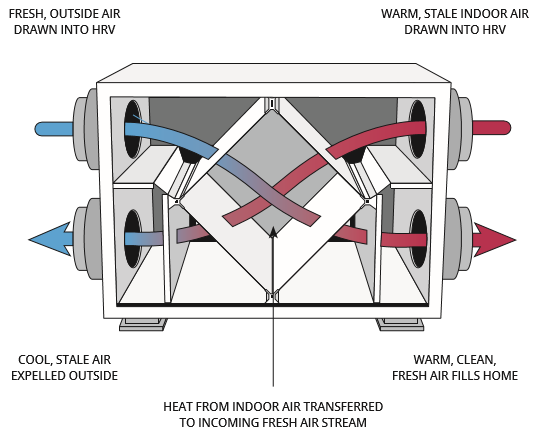How HRV Balances Indoor Moisture Levels
Discovering the Benefits of Heat Recovery Ventilation for Power Efficiency in Residences
Heat Recovery Ventilation (HRV) systems offer homeowners a useful approach to boosting energy effectiveness. By redeeming warmth from outward bound air, these systems can substantially decrease heating and air conditioning prices. In addition, they offer a constant supply of fresh air, enhancing interior air high quality and convenience degrees. As home owners think about lasting options, comprehending the subtleties of HRV systems ends up being increasingly vital. What factors should one assess before making such a financial investment?
Comprehending Heat Recovery Ventilation Systems

How HRV Enhances Indoor Air Top Quality

Energy Financial Savings: The Economic Advantages of HRV
Optimizing energy performance, heat recovery ventilation (HRV) systems offer considerable monetary benefits for homeowners. By recuperating and reusing warm from exhaust air, HRVs substantially minimize heating and air conditioning expenses. This technology can lead to power cost savings of approximately 30%, depending on climate and usage patterns. Homeowners usually discover lowered energy bills quickly after setup, making HRVs a financially sensible financial investment with time. Additionally, lots of regions give incentives or discounts for energy-efficient upgrades, further view boosting the monetary allure. As energy rates remain to rise, the cost-effectiveness of HRVs comes to be increasingly clear. In general, the consolidation of HRV systems not just advertises energy effectiveness yet additionally adds to lasting monetary savings for homes.
The Ecological Effect of Heat Recovery Ventilation
A considerable ecological benefit of heat recovery ventilation (HRV) systems hinges on their ability to reduce general power consumption. By recovering heat from exhaust air and moving it to inbound fresh air, HRV systems reduce the requirement for energy-intensive home heating and cooling down approaches. This reduction in power need adds to lower greenhouse gas exhausts, as much less fossil gas is called for to preserve comfortable interior temperature levels. Furthermore, HRV systems enhance indoor air top quality by successfully trading stale air with get redirected here fresh outside air, reducing dependence on mechanical air conditioning systems that can hurt the atmosphere. On the whole, the application of HRV systems supports sustainable living practices and aligns with worldwide initiatives to deal with environment change by promoting power performance in residential setups.
Choosing the Right HRV System for Your Home
How can house owners ensure they select the best heat recovery ventilation (HRV) system for their demands? First, they need to evaluate their home's dimension and format, as these variables affect airflow demands. Next, reviewing the system's effectiveness rankings is crucial, as higher rankings suggest much better efficiency and energy financial savings. House owners must likewise consider installation and maintenance prices, contrasting different brands and designs for worth. In addition, it is essential to evaluate noise levels, as some systems run even more silently than others. Consulting with HVAC experts can provide tailored suggestions based upon details home conditions. Analyzing individual evaluations and service warranties can aid in making a notified choice, ensuring that the picked HRV system successfully enhances indoor air high quality and power effectiveness.
Regularly Asked Inquiries

Exactly how Typically Should I Clean or Preserve My HRV System?
The frequency of cleansing or preserving a warmth recuperation air flow (HRV) system normally depends on use and environmental aspects. Usually, it is suggested to execute upkeep every six months to ensure peak efficiency and air high quality.

Can HRV Solutions Help Lower Moisture Degrees Indoors?
HRV systems can successfully minimize indoor humidity levels by exchanging stagnant, humid air with fresh, drier air from outside. HRV Heat Recovery Ventilation. This procedure aids keep a well balanced indoor environment, enhancing comfort and avoiding moisture-related concerns
What Is the Life-span of a Normal HRV System?
The life-span of a common heat recovery ventilation (HRV) system differs, usually lasting between 10 to 15 years. Normal upkeep can extend its efficiency and functional life, guaranteeing peak efficiency throughout its use duration.
Exist Any Type Of Noise Issues With HRV Systems?
Noise problems with HRV systems can emerge, especially from follower procedure. Many modern units are designed to minimize audio degrees, guaranteeing they operate silently while maintaining efficiency, which addresses prospective disturbances in living environments.
Can I Set Up an HRV System Myself, or Do I Required a Professional?
The private contemplated whether to set up the heat recovery ventilation (HRV) my blog system directly or employ a specialist. Usually, while do it yourself setup is feasible, knowledge warranties appropriate capability and conformity with neighborhood building regulations, enhancing system performance.